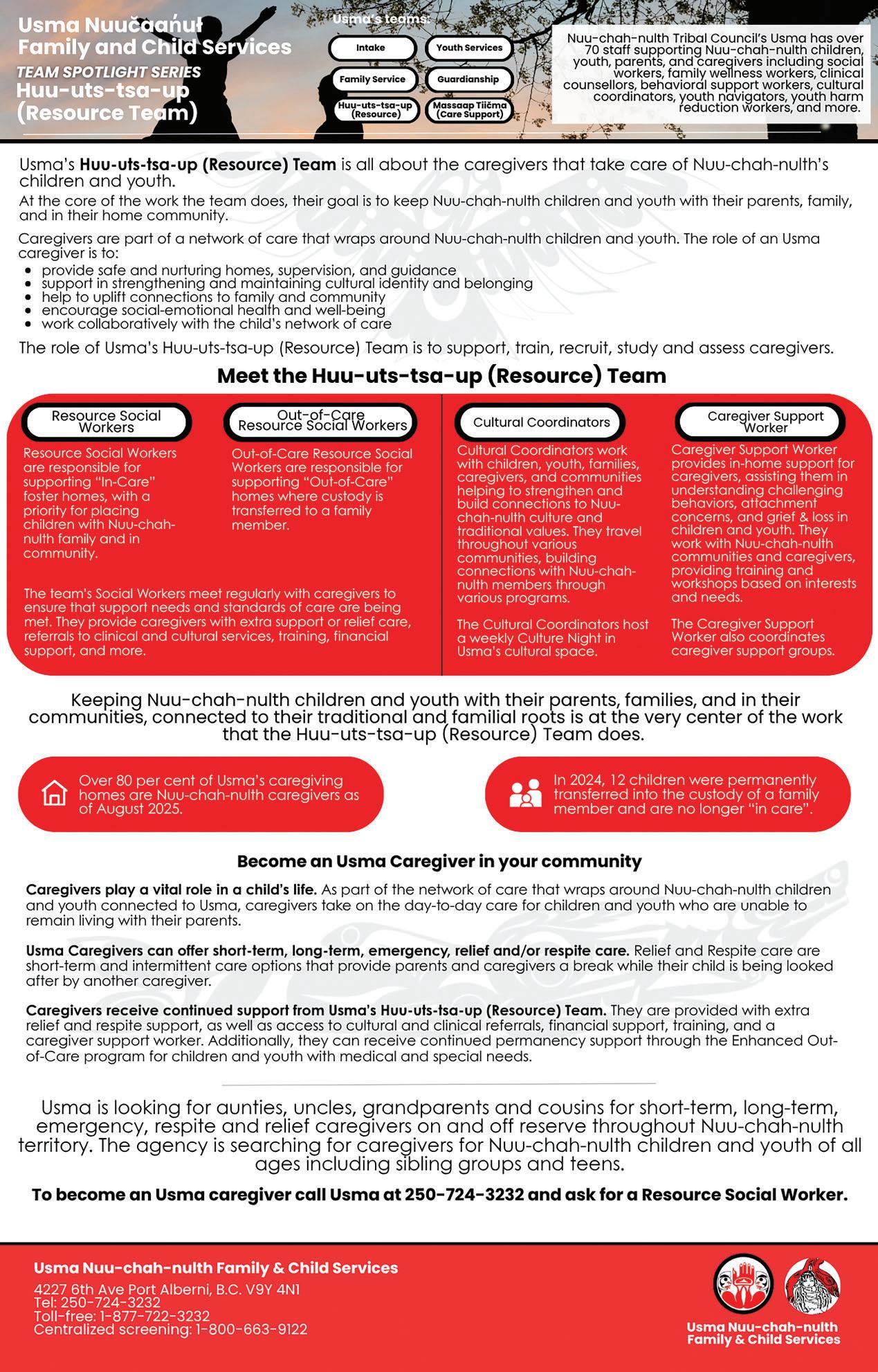

INTERESTING NEWS

Nuu-chah-nulth veterans honoured
Hallway Gallery below Tofino Legion opens with wall of Nuu-chah-nulth war vets
By Nora O’Malley Local Journalism Initiative Reporter
Tofino, BC – A new community art gallery space dubbed the Hallway Gallery was warmed on Nov. 6 with traditional songs, a shared meal and stories of fallen soldiers as Tofino Arts Council (TAC) celebrated the opening of their first exhibit, ‘Remembering Nuu-chah-nulth Veterans’.
Located below the Tofino Legion, the Hallway Gallery exhibit features a memory wall of Nuu-chah-nulth war veterans and a display of 25 beaded poppies to honour the Nuu-chah-nulth soldiers who have fought for Canada and the United States in wars.
“It was important to me that the first exhibit be about recognizing where we are - more than just a land acknowledgement through words, it’s putting it into action,” said TAC Executive Director Carly Butler.
Until 1951 an Aboriginal vet wasn’t allowed to share a toast honouring lost comrades in a Royal Canadian Legion, according to Veterans Affairs. At the National War Memorial in Ottawa Indigenous veterans and their families weren’t permitted to lay wreathes or have their own guards until the mid 1990s.
“So you came back from World War II and you couldn’t even be with everyone and all your comrades,” Butler said.
“I learned so much. I really did. If people have memories, they can write them down and hopefully by the end of the exhibition we will have a wall of stories and memories and names that people have added,” she said.
Grace George and Darlene Frank sourced all the historical photos for the inaugural Hallway Gallery exhibit. The collection includes Nuu-chah-nulth war veterans from the First World War, the Second World War and Vietnam.
“I’m really happy that it’s up there,” said George during the opening celebration.
Her father, the late Chief Earl Maquinna George, left Ahousaht when he was 16 to enlist in the Canadian Army.
“He got to Vancouver, he enlisted, he got trained and of all things, my dad was in the Scottish Regiment. So guess what he was wearing? A kilt!” she said as the room stirred with laughter.
“He just got as far as Halifax. They didn’t send him over because he was too young. He was starting to board the boat to England and he got stopped,” George shared. “But because he was trained and ready to fight, they gave him veteran

status.”
Nuu-chah-nulth artist Elizabeth George leads a weekly Thursday beading group in the new art hub beside the Hallway Gallery. Her mom Annie, who taught Elizabeth how to bead, brings food for the whole group too.
With the guidance of Tla-o-qui-aht elder Levi Martin, the space was named ʔuušmaʕukʔas Arts & Commerce Hub, which translates to ‘the place of creative people’ and is pronounced: ‘oosh-mahuhk-ahs’.
Elizabeth and six of her beading groupies created 25 poppies in a day.
“We had a time crunch,” said Elizabeth, noting that she loves the new art space.
“We get some tourists coming in,” she said. “We made an Orange Shirt with them and explained what they were all about.”
TAC hopes to honour the Nuu-chahnulth Veterans each year with the photo exhibit and beaded poppies display.
“This is the beginning of the conversation,” said Butler.
‘Remembering Nuu-chah-nulth Veterans’ is running until at least the end of the month.
With assistance from Grace George, Darlene Frank and the Ucluelet Secondary School, the Ha-Shilth-Sa has compiled the following list of Nuu-chah-nulth war veterans:
Douglas David, Tla-o-qui-aht – Served 24 years in the US Navy; Vietnam War Veteran and decorated sailor
James Swan, Ahousaht
Jack (John) Watts, Tseshaht
Frank Williams, Checklesaht/Ahousaht
– World War II; Canadian Army
this issue... Migratory salmon potlatch..............................................Page 3
‘Very serious error’ in Cowichan ruling.........................Page 5
living and the valley’s housing shortage..............Pages 8-9
Tim Paul Sr., Hesquiaht – World War II; Canadian Army
Earl Maquinna George, Ahousaht –World War II; Canadian Army; former Ahousaht Chief councillor
Edward Clutesi, Tseshaht – World War II; Canadian Army
Ramona Gus, Tseshaht
Phillip Louie Sr, Ahousaht – World War II
John Jacobson, Ahousaht – World War II; Canadian Army (Infantry)
George Clutesi Jr, Tseshaht
Tom Gus, Tseshaht
Fred Gus, Tseshaht
Danny Gus, Tseshaht
Angus Campbell Sr., Ahousaht – World War I & II; Canadian Infantry (BC Regiment),
Thomas Jones, Nuu-chah-nulth
M. Amos, Hesquiaht
J. George, Hesquiaht
Andrew Webster Sr., Ahousaht
Francis Harry Charlie, Tla-o-qui-aht –World War II; Royal Canadian Army
Luke Mahone, Ditidaht
George Hamilton, Hupacasath
Theodore George, Ahousaht
Victoria Nancy Joe-Mack, Toquaht
Henry Vincent Thomas, Tseshaht, Jerid Clutesi, Tseshaht
Lorraine Mundy, Yuułuʔiłʔatḥ
Benedict David, Nuu-chah-nulth – Vietnam War
Victoria Nancy Mack, Toquaht
Sam Johnson, Mowachaht
If you know of a Nuu-chah-nulth war veteran who is not included in this list, please contact Ha-Shilth-Sa at 250-7245757.
KCFN sees historic change in government
By Eric Plummer Ha-Shilth-Sa Editor
Kyuquot, BC - On Oct. 17 the Ka:’yu:’k’t’h’/Che:k’tles7et’h’ First Nations marked a historic development in their government, with the first time hereditary positions have been changed to their legislature since the Maa-nulth treaty was implemented in 2011.
Two of the four ha’wiih positions on the First Nation’s legislature saw new representation, with the swearing in of Ha’wilth Maxine Dragon Gillette and Ha’wilth Anthony Oscar, two hereditary leaders representing the Che:k’tles7et’h’ nation. Maxine Gillette was formally seated as the Tyee of Che:k’tles7et’h’on Sept. 13, a title passed from her father Francis Gillette. Anthony Oscar was seated as a Che:k’tles7et’h’ Ha’wilth on Oct. 11 by his father William (Bill) Oscar. “They’ve aged and handed their seats down to their children,” said KCFN Legislative Chairman Matthew Jack of the passing of the hereditary seats. “It’s the first time we’ve seen that with our new government.”
Since the Maa-nulth Final Agreement was implemented on April 1, 2011, the Ka:’yu:’k’t’h’/Che:k’tles7et’h’ First Nations have been led by a legislative body composed of an elected chief, four elected members and four ha’wiih, which include two hereditary chiefs from Ka:’yu:’k’t’h’ and two from Che:k’tles7et’h’. These hereditary positions on the legislature are appointed by a Ha’wiih Advisory Council, according to the First Nation’s laws. The other two hereditary positions on the legislature are currently being held by Tyee Ha’wilth Samantha Christiansen and Ha’wilth Valerie Hansen from Ka:’yu:’k’t’h’. The legislature meets every month to vote on major decisions facing KCFN. Elected on April 18, 2023, Benjamin Gillette is the legislative chief, joined by fellow elected members Lillian Jack, Devon Hansen, Larissa Hansen and Matthew Jack.
A stipulation in the Maa-nulth treaty ensures that Ka:’yu:’k’t’h’/Che:k’tles7et’h’ governance will include hereditary representation.
“That way we can incorporate our traditional values and stuff into the modern government,” explained Matthew Jack.
Nora O’Malley photo
Grace George admires a photo of her father, the late Chief Earl Maquinna George, who was a young soldier in the Canadian Army during World War II.

Salmon potlatch commits to health of migrating stocks
Fish farms now have until 2029 to remove net pens, a deadline some nations say infringes on territorial rights
By Eric Plummer Ha-Shilth-Sa Editor
Port Alberni, BC - With time running out for salmon farming as we know it on the B.C. coast, a potlatch in Port Alberni delivered another blow of opposition to the industry.
Hundreds came to the Alberni Athletic Hall on Nov. 1 and 2 for the potlatch held to celebrate migratory salmon. Hosted by Hupacasath Ha’wilth Tsu Tsii In, Alton Watts, and Hesquiaht elder and artist Aniičačist, Tim Paul, the gathering was held to display a “commitment to the health of migratory wild salmon in the face of continued threats from open net pen fish farms.” The potlatch brought together chiefs from across Vancouver Island and as far south as the Winnemem Wintu Tribe from California, where leaders signed a declaration “on wild salmon and the economic and cultural health of B.C.’s coastal communities”.
“We want to invite you to a feast and look at what fish farms are doing to our waters and estuaries and rivers,” said Paul in an online video inviting people to attend the potlatch.
“Our understanding is that we can not break that cycle of nature and kill those rivers with what’s happening and what is discharged from fish farms in the ocean,” he continued. “We can’t live without the wild stock of migratory salmon, and the fish farms are devastating to those parent streams and killing the life, taking the life out of those rivers.”
The potlatch presents the latest round of opposition to salmon farming on the B.C. coast, following a statement from the B.C. First Nation Wild Salmon Alliance issued last year that listed over 120 Indigenous communities – encompassing most First Nations in British Columbia – who stand behind banning from the ocean the industry standard of open net pens.
With 65 sites still on the B.C. coast –most of which are in Nuu-chah-nulth ter-

Hundreds came to the Alberni
Hupacasath Ha’wilth Tsu Tsii In, Alton
on Nov. 1 and 2 for a potlatch held to celebrate migratory salmon. Hosted by
and
elder and artist Aniičačist, Tim Paul, the gathering was held to display a “commitment to the health of migratory wild salmon in the face of continued threats from open net pen fish farms.”
ritory - British Columbia remains the outlier on the Pacific Northwest as the only jurisdiction to still allow salmon farming in the ocean. But more opposition might not be necessary if the federal government goes through with the deadline of June 30, 2029 for all open net pens to be removed from coastal waters.
This isn’t necessarily a good thing for coastal Indigenous communities, according to the Coalition of First Nations for Finfish Stewardship, which lists 17 First Nations that have formal agreements with salmon farming companies. In Nuu-chahnulth territory this includes the Ehattesaht, Tla-o-qui-aht and Ahousaht First Nations.
“We do not tell our neighbouring communities or people in urban centres how to manage their lands and waters, and they do not have the authority to dictate
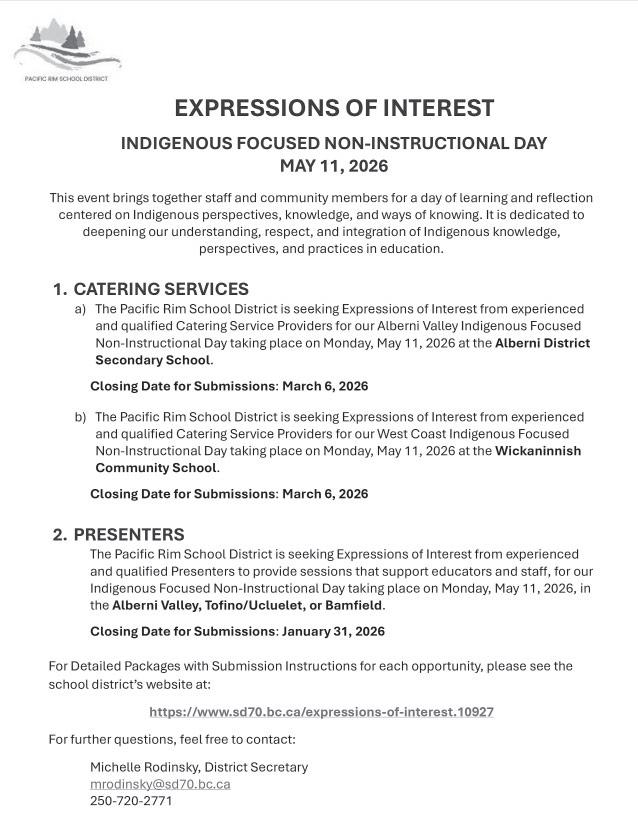

what happens in ours,” said the coalition in a recent statement. “Canada cannot afford, economically, socially, or morally, to shut down a modern, sustainable, Indigenous-led industry in the face of growing food insecurity, global trade instability, and a worsening housing crisis.”
For over a decade Ahousaht has had a protocol agreement with Cermaq, which operates salmon farms in the First Nation’s territorial waters in Clayoquot Sound. This is valued at $6 million annually in employment, educational supports and transportation assistance, according to Ahousaht Tyee Ha’wilth Hasheukumiss, Richard George.
“Our Ahousaht rights and authority are directly being disrespected,” said George during a Nuu-chah-nulth Council of Ha’wiih Forum on Fisheries meeting Feb. 12.
He was addressing representatives from Fisheries and Oceans Canada at the meeting, noting how the government was breaking its commitment to not remove the salmon farms from his hahuułi. Over 20 Ahousaht members work on the Cermaq sites, offering valuable employment for the remote Flores Island First Nation community.
“That was a verbal commitment,” said the hereditary chief, regarding a past visit from former fisheries minister Dianne Lebouthillier. “We did protocol and honoured her with a mask to cement that in stone, only to be slapped in the face with your transition plan.”
With the 2029 deadline, the federal government has taken the side of the many concerned that fish farms pose a risk to wild salmon through the spread of disease. In 2023 the Pacific Salmon Foundation reported that the closeness of fish in ocean pens “present ideal conditions for amplification of viruses, bacteria and parasites.” The PSF also blames the
farms – which usually raise Atlantic salmon – for introducing piscine orthoreovirus to the Pacific coast.
Yet fish farms were rarely mentioned in the PSF’s latest annual report on the state of the species. Aquaculture was listed as one factor among many that threaten Pacific wild stocks, including urbanization, ocean predators, interbreeding with hatchery-raised fish, a warming marine environment and forestry. On western Vancouver Island, decades of industrial logging are blamed for having “stripped much of the old growth forest and significantly altered stream habitats.”
Salmon stocks have been in decline for decades – a trend that has devastated commercial fishing on the B.C. coast – and two thirds of populations remain below their long-term averages, according to the PSF report. But the last year has shown signs of improvement to some species in southern parts of the province.
“Pink salmon are grabbing headlines for their burgeoning numbers throughout the North Pacific, which is good news for salmon-dependent communities and ecosystems,” stated the report. “Pink salmon seem to respond better than other species to a warming ocean and are less exposed to climate changes in freshwater due to their short, marine-dominated lifecycle.”
On western Vancouver Island, the average annual abundance of chinook salmon from 2020-2023 was 355,233 – significantly higher than the average of 242,134 that the PSF tracked back to 1985.
“In west Vancouver Island and east Vancouver Island and Mainland inlets, both spawner and total abundances are well above the long-term average,” said the report of the chinook numbers. “This rebound - also seen on the Central Coast - is driven in part by hatchery enhancement of wild populations.”
Irine Polyzogopoulos photo
Athletic Hall
Watts,
Hesquiaht
Fernando Lessa photo
Ha-Shilth-Sa newspaper is published by the Nuu-chah-nulth Tribal Council for distribution to the members of the contributing First Nations, as well as other interested groups and individuals.
Information and original work contained in this newspaper is protected by copyright and may not be reproduced without written permission from:
Nuu-chah-nulth Tribal Council P.O. Box 1383, Port Alberni, B.C. V9Y 7M2.
Telephone: (250) 724-5757
Fax: (250) 723-0463
Web page: www.hashilthsa.com facebook: Hashilthsa Ntc
2025 Subscription rates:
Non-Nuu-chah-nulth, Ahousaht, Ehattesaht,Toquaht and Ucluelet members are subject to a yearly subscription fee of $40 in Canada, $50 in the US and $60 for overseas. Payable to the Nuu-chah-nulth Tribal Council
Manager/Editor/Reporter
Eric Plummer (Ext. 243) (250) 724-5757 Fax: (250) 723-0463 eric.plummer@nuuchahnulth.org
Reporter
Denise Titian (Ext. 240) (250) 724-5757 Fax: (250) 723-0463 denise.titian@nuuchahnulth.org
Reporter
Nora O’Malley (604) 353-8488 nora.omalley@nuuchahnulth.org

Audio / Video Technician
Mike Watts (Ext. 238) (250) 724-5757 Fax: (250) 723-0463 mike.watts@nuuchahnulth.org
Editorial Assistant
Holly Stocking (Ext. 302) (250) 724-5757 Fax: (250) 723-0463 holly.stocking@nuuchahnulth.org
DEADLINE:
Please note that the deadline for submissions for our next issue is Nov. 21. 2025
After that date, material submitted and judged appropriate cannot be guaranteed placement but, if material is still relevant, will be included in the following issue.
In an ideal world, submissions would be typed rather than hand-written. Articles can be sent by e-mail to holly.stocking@nuuchahnulth.org (Windows PC).
Submitted pictures must include a brief description of subject(s) and a return address.
Pictures with no return address will remain on file. Allow two - four weeks for return.
Photocopied or faxed photographs cannot be accepted.
COVERAGE:
Although we would like to be able to cover all stories and events, we will only do so subject to:
- Sufficient advance notice addressed specifically to Ha-Shilth-Sa.
- Reporter availability at the time of the event.
- Editorial space available in the paper.
- Editorial deadlines being adhered to by contributors.
LETTERS and KLECOS
Ha-Shilth-Sa will include letters received from its readers. Letters MUST be signed by the writer and have the writer’s full name, address and phone number on them. Names can be withheld by request. Anonymous submissions will not be accepted. We reserve the right to edit submitted material for clarity, brevity, grammar and good taste. We will definitely not publish letters dealing with tribal or personal disputes or issues that are critical of Nuu-chah-nulth individuals or groups. All opinions expressed in letters to the editor are purely those of the writer and will not necessarily coincide with the views or policies of the Nuu-chah-nulth Tribal Council or its member First Nations. Ha-Shilth-Sa includes paid advertising, but this does not imply Ha-Shilth-Sa or Nuu-chah-nulth Tribal Council recommends or endorses the content of the ads.
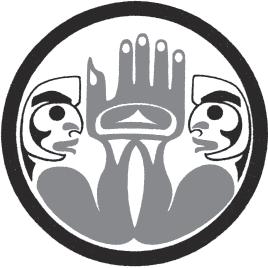

Port authority cut from running marina
City ‘assessing the existing infrastructure’ at Clutesi Haven and Harbour Quay
By Denise Titian Ha-Shilth-Sa Reporter
Port Alberni, BC – The City of Port Alberni has announced that it will not be renewing leases with the Port Alberni Port Authority after the two parties failed to come to an agreement on the cost.
In a statement issued October 28, 2025, the City of Port Alberni said it has issued formal notice of termination for the land lease agreements with the Port Alberni Port Authority (PAPA).
“This decision, reached after extensive discussions, comes as part of the city’s broader strategic planning to ensure the highest and best use of its land in a way that is fair and equitable for taxpayers,” wrote the city.
The affected properties include Clutesi Haven Marina and Parcel C at Harbour Quay. The Uchucklesaht First Nation uses the Harbour Quay site to land their water taxi, but the city says the recent changes will not affect local businesses.
The city will, for now, take over management of the affected properties. Mike Fox, chief administrative officer for the City of Port Alberni, says the city is in active discussions with the Uchucklesaht regarding their moorage to ensure continuity.
Further, the city says the transition will
not affect operations at Clutesi Haven Marina, nor will it disrupt the services provided by the food trucks currently located on-site.
“The city is committed to maintaining public access to the marina, boat launch, and parking areas. Further, the city will assume management of the developing vendor village, green spaces, performance stage, and outdoor dining area,” said the city in a written statement.
The changes will take effect over the coming months while the city reviews options for the long-term management of Clutesi Haven Marina and the Harbour Quay dock.
“We’re assessing the existing infrastructure to determine the best approach for community benefit,” they stated.
Fox says the city has been working alongside the Tseshaht and Hupacasath First Nations regarding plans for Clutesi Haven Marina.
“The city values its relationships with local First Nations and is open to partnership opportunities as operational plans evolve,” he added.
As for the business relationship with Port Alberni Port Authority, Fox stated, “while we deeply value the years of partnership with PAPA, this decision ultimately reflects what is best for our community. We are committed to ensur-

Ha-Shilth-Sa belongs to every Nuu-chah-nulth person including those who have passed on, and those who are not yet born. A community newspaper cannot exist without community involvement. If you have any great pictures you’ve taken, stories or poems you’ve written, or artwork you have done, please let us know so we can include it in your newspaper. E-mail holly.stocking@nuuchahnulth.org. This year is Ha-Shilth-Sa’s 51st year of serving the Nuu-chah-nulth First Nations. We look forward to your continued input and support. Kleco! Kleco!
ing the continued growth and success of Port Alberni, and this step will help us achieve that.”
“We extend our gratitude to PAPA for years of cooperation and wish them continued success in their future endeavors,” Fox added. “We look forward to working directly with the community to make the most of Clutesi Haven Marina ensuring it continues to contribute positively to the vibrancy of Port Alberni.”
The Port Authority continues to manage much of the city’s waterfront, including three dee-sea shipping berths, other parts of the Harbour Quay and The Dock+, which is home to several businesses.
PAPA also manages the China Creek Campground and Marina south of the city.
“As an Agent of the Federal Crown, the Port Alberni Port Authority operates independently from the federal government while contributing two per cent of all gross revenue to it,” states the Port Authority on its website. “Additionally, we hold a headlease with the Province of British Columbia, managing the foreshore of certain waters in the Alberni Inlet and sharing 50 per cent of the gross revenue earned within these waters with the province.”
Legal Information
The advertiser agrees that the publisher shall not be liable for damages arising out of errors in advertisements beyond the amount paid for space actually occupied by the portion of the advertisement in which the error is due to the negligence of the servants or otherwise, and there shall be no liability for non-insertion of any advertisement beyond the amount paid for such advertisements
Eric Plummer photo
A boat leaves the Clutesi Haven Marina, as Tseshaht and Hupacasath members fish for sockeye in the Somass River.
Tofino businesses expect 44 per cent revenue growth
Recent chamber survey notes insufficient housing leaves 34 per cent of businesses operating under full capacity
By Antonella Medina Arias Ha-Shilth-Sa Contributor
Tofino, BC — A new report highlights both the strengths and ongoing challenges of Tofino’s economy, showing signs of improvement in recent years while drawing attention to persistent barriers facing local businesses.
The Tofino Chamber of Commerce released this year’s Business Retention and Expansion (BRE) Summary Report on October 23, providing a detailed analysis of the resort town’s current economic climate based on the testimony of 50 business owners across all major sectors.
Data gathered between May 2024 and March 2025 shows a resilient business community committed to growth, yet facing challenges in infrastructure limitations, housing shortages, workforce pressure and governmental concerns.
“This report gives voice to the lived realities of our business community,” said Samantha Hackett, executive director of the Tofino Chamber of Commerce, in a press release. “We heard from 50 local businesses, and while their sectors differed, their challenges are interconnected. It’s clear that real solutions will require collaboration across government levels, communities, and industries.”
Despite the challenges, Tofino’s business community shares positive news.
The report shows that 44 per cent of businesses plan to expand over the next three to five years, 66 per cent of businesses reported revenue growth, and many see improvements in regional collaboration, policy reform, and relevance for tourism.
A business forecast estimates 44 per cent revenue growth over the next three years.
Ahousaht Tyee Ha’wilth Maquinna, Lewis George, who is owner of the House of Himwitsa Native Art Gallery located in Downtown Tofino, says the town’s current economic status is excellent.
“People [are] visiting the west coast from all over the world [and] from Canada within,” said George. “We’ve had a really good season, and we haven’t seen the economics like this for a long time.”
George comments on how European tourists continue to fill the rooms at his lodge even after the end of September, when tourism presence starts to drop.
However, the report identified multiple obstacles faced by local businesses, posing as barriers to Tofino’s economic development.
The infrastructural limitations of highways, local roads, and hospitals continue

to be a significant challenge for both habitable and economic sustainability.
Particularly in the Highway 4 closure for improvements, as 90 per cent of owners expressed concerns about the lack of transparency, communication, and planning when the road is worked on.
“There’s over a million people that come to visit the National Park [and Tofino] every year,” said George. “Whenever the road is closed . . . it hurts our bottom line because nobody is shopping. The road is a central means of getting here, because it’s the only [way in].”
According to the BRE report, 62 per cent of businesses say the housing crisis is directly affecting their ability to hire and retain staff. Insufficient housing has left 34 per cent of businesses operating under full capacity. Although 48 per cent offer staff accommodation, only 71 per cent own the establishment themselves.
Workplace pressure is another growing issue, linked to the lack of affordable housing, skill shortages and rising burnout levels. About 75 per cent of business owners reported experiencing high levels of burnout. The report revealed that 70 per cent of staff feel overwhelmed and burned out, with 40 per cent working multiple jobs just to afford housing.
“Tofino is a challenging place to attract and retain workers due to the lack of housing,” shared one of the interviewed
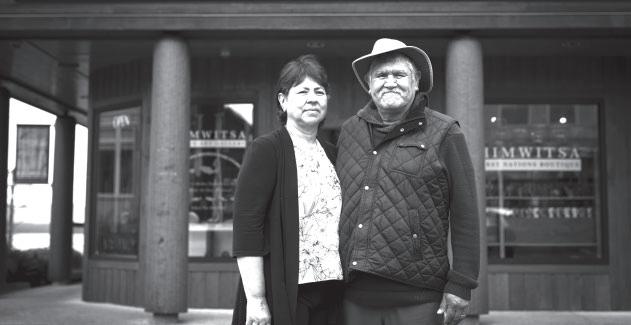
local owners in the RME report. “It’s a huge issue now and for the foreseeable future. The quality of housing is also poor, which makes the quality of living a challenge, which diminishes the quality of staff. It’s a full-circle problem.”
Tofino’s government also emerged as a key concern from the locals’ perspective.
Many business owners cited a lack of trust, inconsistent policy enforcement and urged for a greater transparency and longterm planning from government officials.
Nearly 90 per cent of owners reported challenges related to local regulations. In addition, 78 per cent raised concerns about the provincial government’s limited investment in tourist destinations and the
rising cost of commerce, while 75 per cent pointed to issues with transportation access and infrastructure support.
The report proposes strategic opportunities for addressing every challenge presented, focusing on areas such as water infrastructure, year-round tourism development, regional licensing, and destination housing models inspired by the Whistler and Squamish communities.
To view the full report, please visit: https://static1.squarespace.com/ static/55ae982de4b0d41522afbc4b/t/68fa 653491d2a120e1be19f5/1761240372088/ Tofino+Chamber+2025+BRE+Report+S ummary.pdf

Melissa Renwick photos
Approximately one million visitors each year come to Tofino, which rides a reputation of being the surf capital of Canada. Pictured is a surfer walking out of the ocean on Long Beach, near Tofino, on April 14, 2021.
Along with his wife Cathy, Ahousaht Tyee Ha’wilth Maquinna, Lewis George, is owner of the House of Himwitsa Native Art Gallery located in Downtown Tofino.
Harbour Air links Tofino and Vancouver this winter
A 19-passenger aircraft will fly the route four times a week, adding to the existing services from Pacific Coastal
By Nora O’Malley Local Journalism Initiative Reporter
Tofino, BC – Harbour Air is running a new 19 passenger flight service from Vancouver to Tofino all winter.
The new route between Vancouver International Airport’s South Terminal (YVR) and Tofino-Long Beach Airport (YAZ) offers four weekly departures on Mondays, Thursdays, Fridays and Sundays, with one-way fares starting at $139. (People living in the west coast region are eligible to receive a 20 per cent discount with a valid ID; use promo code TOFINOLOCAL20.)
“What a fantastic day,” said Chris Fordyce, Harbour Air Chief Commercial Officer, after the inaugural 45-minute flight touched down on a balmy Oct. 27 afternoon.
“It’s like we were blessed on our launch. My only experience of Tofino up until now has been rain so I almost couldn’t believe it was sunny,” said Fordyce.
Donning aviator sunglasses and a black Tribal Parks Guardian bomber jacket, Gisele Martin welcomed guests to Tla-o-qui-aht First Nation traditional territory. She introduced the group to the ʔiisaak Pledge (ii-saak), which includes the teachings of respect for natural law, speaking truthfully and acting honourably, building community and leaving no trace.
“If we think of the time span of Indigenous nations on the coast, there are some elders who spoke of Indigenous history

O’Malley photo Tla-o-qui-aht Tribal Parks Guardian Gisele Martin welcomes visitors to Tla-oqui-aht traditional territory.
not only in human generations, but 20 cedar tree generations ago and a cedar tree can be 2,000 years old, so in that timespan of thousands of years, Canada is a tiny blip of time,” said Martin.
“We are in early contact, right now, as we speak,” she continued. “Thank you for arriving today. We look forward to your service and safe travels back and forth.”
Tofino mayor Dan Law spoke about
how beautiful the region is every season of the year. He noted how the additional transportation service will benefit not only visitors, but residents too.
“This is a tremendous service for our residents who want to get out of town for any medical reasons or whatever you need,” said Law.
Fordyce said Harbour Air supports Hope Air, a charity offers free transportation to Canadians in financial need who must
access medical care away from home.
He said they are also looking at ways to support Tla-o-qui-aht Tribal Parks.
“For over 40 years we’ve been serving communities like Tofino. It’s all about connecting the communities, connecting tourism and helping British Columbians to explore the beautiful part of the world we live in,” said Fordyce.
Harbour Air’s new wheeled-flight complements their summer floatplane service, which leaves from Vancouver’s Burrard Inlet and docks at Tofino Resort + Marina.
Pacific Coastal Airlines also has regular flights from Vancouver to Tofino-Long Beach Airport.
Fordyce says Harbour Air’s latest Tofino winter offering is “just the beginning” of expansions for the Canadian company and North America’s largest seaplane airline owned by Birch Hill Equity Partners.
“Next summer we will be operating 200 flights a day including new destinations like Campbell River to Ucluelet, Victoria to Seattle and increasing our services to Vancouver and Seattle,” said Fordyce. The current capacity of Tofino-Long Beach Airport is 100 people, but expansion plans for a new terminal are in the works along with a refreshed communications strategy as part of the long-term protocol agreement between Tla-o-quiaht and Alberni-Clayoquot Regional District (ACRD), who took over management of the airport in 2000.
The Government of Canada built the original YAZ runways in 1942-1943 for the Second World War.
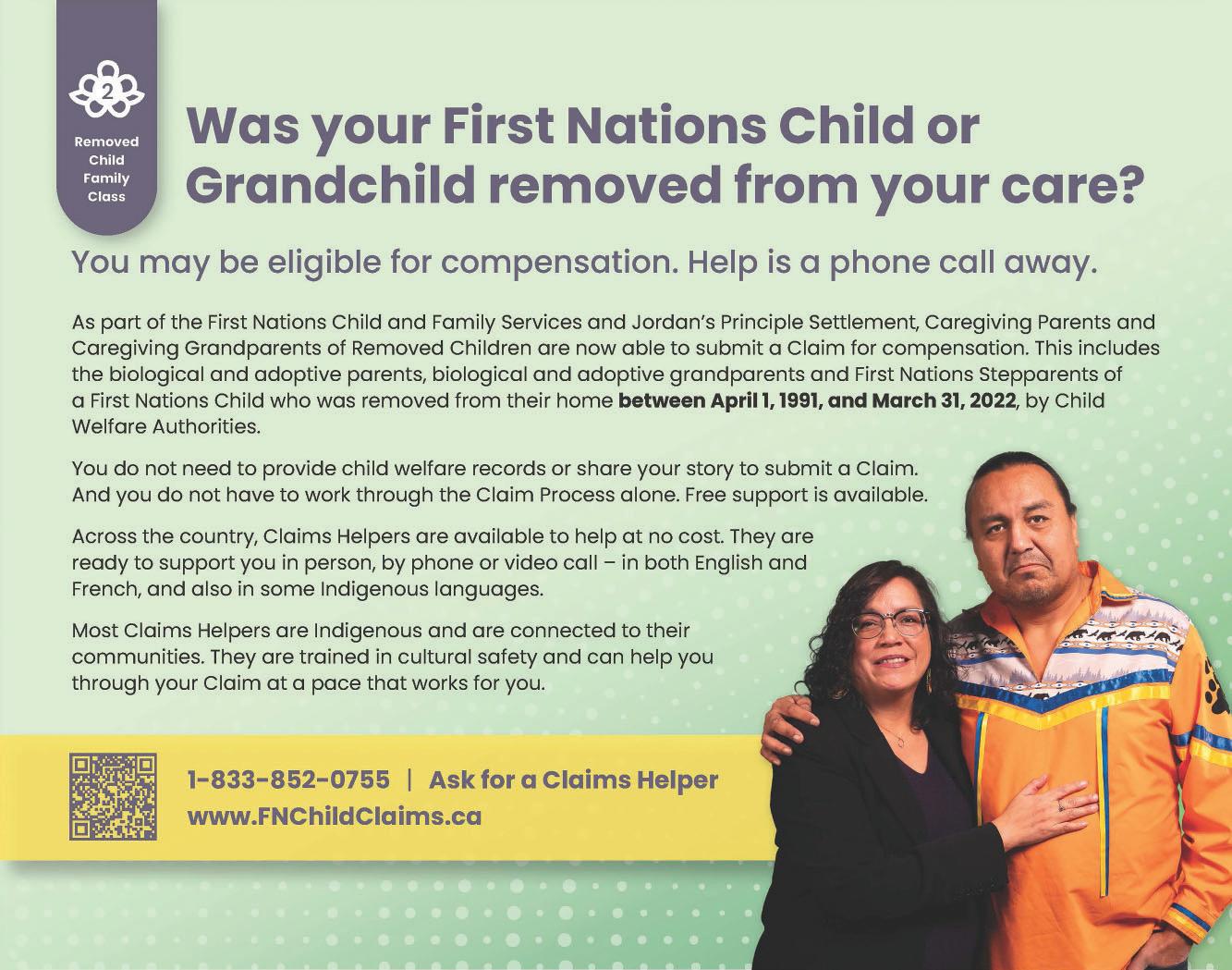
Nora
‘Nowhere else to go’: RV living and the Alberni Va
Due to safety concerns, Port Alberni’s city and First Nations have policies against living in motor homes, but an ongoi
By Eric Plummer Ha-Shilth-Sa Editor
Port Alberni, BC - In mid August the Mount Underwood forest fire erupted south of Port Alberni, sending a mushroom cloud over the community with a current of fear that residents of the small Vancouver Island city might be at risk of losing their homes. The city’s south-end neighbourhood of Cameron Heights was put on evacuation alert, along with the Tiipis Tseshaht reserve at Polly’s Point.
Although this was not an order to evacuate, as a precaution the reserve’s few residents temporarily moved elsewhere to be at a safer distance from the forest fire. But Joe Williams stayed, concerned he might not be able to return to the motor home he has lived in at the waterfront site for the past few years.
“I moved back home a couple of years ago. I’ve got nowhere else to go,” says the 63-year-old Tseshaht member. “I can’t park in anybody’s house, this is the only place I call home.”
On a summer afternoon Williams sits at the helm of the RV bus that has become his home. From his seat the vehicle’s long corridor leads to the bedroom, an expanse lined with the remnants of day-to-day life: coffee cups, papers, tools, framed family photos, stacks of DVDs and a bowl of dried food for his dog Zeus, a sturdy three-yearold Belgian Malinois Williams has had since he was a puppy.
Williams bought the motor home three years ago from a friend.
“A friend of mine sold it to me for a decent price. I paid it off in payments, which was nice,” he explains. “I came from Vancouver. I was going through a hard time over there and lost my housing. I went through a hard spell and decided I just needed to come home.”
Joe’s connection to the waterfront site runs deep. He recalls time there as a child, when his grandmother Cecilia Williams lived in a shack with an outhouse.
“Most of the people lived in houses that were on stilts down here,” he recalls. Joe even stayed in an army tent at the site one winter in the 1990s to work on tearing down the old Alberni Plywood mill. That former industrial site has now become Canal Beach, which is right next to the Tiipis Tseshaht reserve.
“I’m down here, people leave me alone,” reflects Joe. “Nobody bothers me. It’s peaceful down here, it’s quiet.”
Trailer living prohibited on reserves
A pebbled beach stretches along the shore on the other side of Joe’s RV, where the bush opens to the exposed air of the Alberni Inlet. To the south the industrial bones of Port Alberni’s waterfront extend into the distance, part of a territory the Tseshaht First Nation has called home for countless generations. The Tseshaht and Hupacasath, who also are based in the Alberni Valley, continue to rely on their territorial resources – particularly the annual migration of several salmon species that return to the Somass river each year, supporting a fishery that engages a large proportion of the local First Nation community.
But as a modern Indigenous community the Tseshaht’s management responsibilities over its reserve land includes the enforcement of policies, one of which disallows people to permanently live in RVs and trailers.
This led to a letter Joe received from the First Nation in September 2023, which cites “numerous concerns and complaints
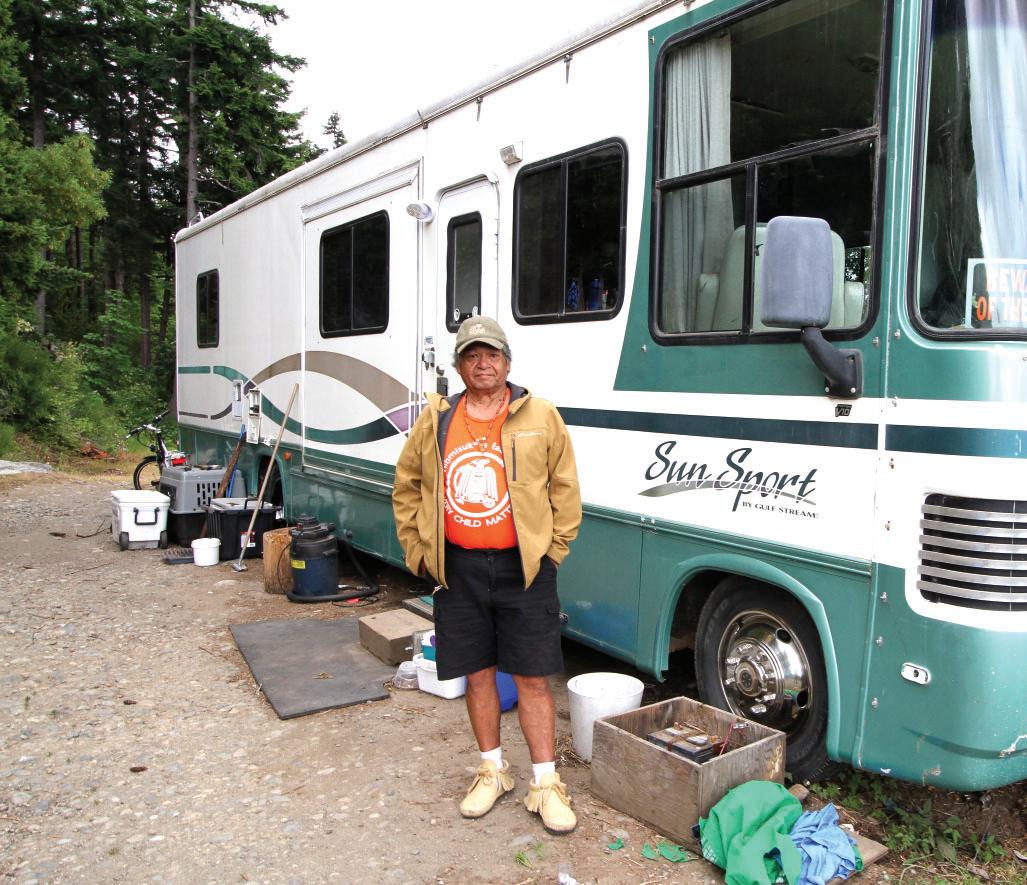
For the last few years Joe
habitation in RVs and trailers. with respect to your camp related to safety and health risks.” The letter acknowledges Joe’s deep ancestral connection to the area, but stresses that Tseshaht’s housing, health and safety policies must be followed.
“As you are aware, we are in a campfire ban, not just in our territory, but throughout much of B.C.,” reads the letter, which was issued amid the worst forest fire season in the history of British Columbia. “The area does not have the necessary infrastructure to support a camp of this nature, including a fire hydrant to deal with firefighting.
Overall, the camp, so constructed, results in unsafe living conditions, not only for yourself, but also for the permanent residents in the area and our territories.”
“It’s Tseshaht council’s fiduciary duty to look after the legal interests of the nation,”
explained Tseshaht Chief Councillor Ken Watts regarding people living in motor homes on the reserves. “If something ever happens we want to make sure that the individual and the community are covered for liability, that everything is all taken care of from an insurance perspective. One of biggest pieces that we’re facing now is we have parts of our community that aren’t serviced by water, so we don’t have fire hydrants in some of these locations.”
Watts admits that the rapid spread of the Mount Underwood wildfire in August presented a frightening scenario for the First Nation, reinforcing the need to prevent forest fires from sparking during drought conditions that have become an annual occurrence in the Alberni Valley.
“Any RV that’s not hooked up properly,
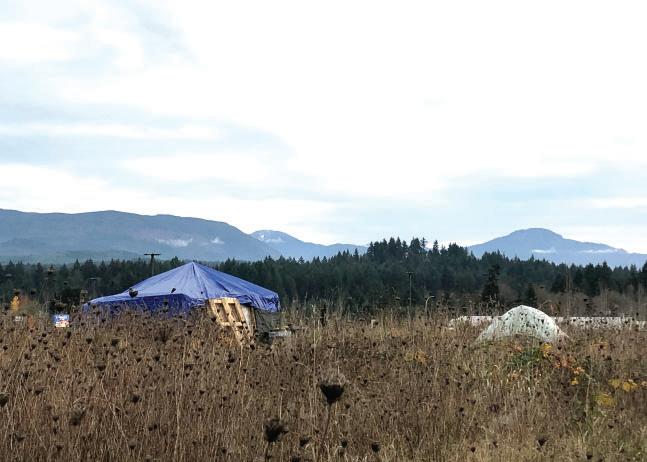
one small incident could have sparked a forest fire,” says the elected chief.
“We’re not looking to throw anybody out, but we have to look out for the safety of the community too.”
Elsewhere in the Alberni Valley, the Hupacasath First Nation also prohibits people from permanently living in RVs and trailers on reserve land. This is only possible when a member has a certificate of possession for a piece of land and needs to live in the trailer temporarily.
“If they have a possession on the land, they are able to move in a trailer and do whatever they want on their land, within reason,” explains Hupacasath Councillor Jared Dick. “They have to make sure they have water and electrical hook ups.”
Dicks adds that a certificate of pos-

Williams has lived in a motor home at Polly’s Point with his dog Zeus, on the Tseshaht’s Tliipis reserve d
A group of motor homes sit in a parking l
Tents are perched atop a hill at the eastern edge of Port Alberni, overlooking the large parking lots for big-box stores.
alley’s housing shortage
ing housing shortage is pushing some to break the rules

Eric Plummer photos despite the First Nation’s policy against session is only granted if the Hupacasath member can show the means to build a permanent structure on the land, making the trailer option strictly temporary for those on reserve.
Scarce on reserve housing
Meanwhile a housing shortage persists in the Alberni Valley. According to a housing report presented to Port Alberni city council last December, the average price of house has gone up 52 per cent since 2020, while condominiums have increased by 117 per cent. Rental prices have also escalated, outpacing gains in income by 33 per cent in the area. This means that Port Alberni needs to have at least another 1,200 homes built by 2030 to meet this growing demand for shelter, states the report.
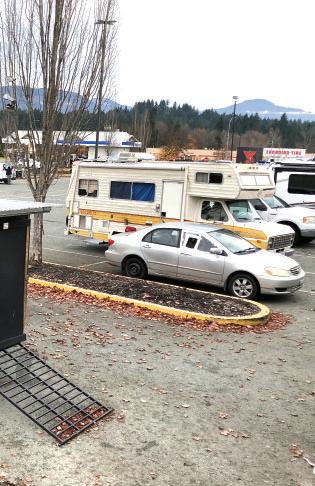
On reserves housing is also scarce, causing long wait lists for the Hupacasath First Nation.
“We have three housing wait lists,” said Dick, referring to the lineups for social supportive housing, rentals and property possession certificates. “Some people have been on those waiting lists for a really, really long time.”
On reserve housing operates under Indigenous Services Canada, and this reliance on the federal department requires a pre-feasibility study, plus two more assessments, explains Dick.
“Each study you need for ISC takes upwards of two years, so by the time they’re all done, getting everything developed and paid for, it’s six years down the line,” he says, noting that Hupacasath has tried to speed up this process by doing the feasibility studies themselves.
The First Nation’s main reserve in Port Alberni’s municipal boundaries is almost full, leading Hupacasath to clear lots on the Klehkoot reserve two kilometres west of the city.
“Ahahswinis is almost fully developed, so now we have to seek our other reserves, which are much further away for development,” says Dick.
On the Tseshaht reserve there are currently just four unoccupied homes, all of which are deemed unsafe to live in and are owned by members who have dwellings elsewhere, according to the First Nation’s housing department. In hopes of catching up with the housing demand, Tseshaht has even invested in property outside of its reserve land, purchasing a parking lot by the now-closed Alberni Pacific Division sawmill for a future development. Announced in the spring of 2024, the acquisition of the 7.9-acre lot was made possible by a $5-million grant that came from the provincial government the previous year.
The First Nation is also looking into opening an RV park, something that the community has needed for years. This park would have water and hopefully sewer connections for those living in motor homes, says Watts.
“Our staff are doing feasibility work on at least one location now, just making sure that we have water servicing,” he says. “We don’t want to make anybody homeless.”
“We’ve made it really clear that individuals need to work with the nation,” adds Watts. “We’ve made some amendments to try and help people, because we know the cost of living is high, rent is high.”
Joe Williams says his First Nation told him in the past that elders’ housing was becoming available, but he wouldn’t be able to bring his dog. Joe can’t imagine living without Zeus, a companion who helps with his anxiety, which Joe admits he is taking medication for.
For over 20 years Joe had a career as a long-haul mover, travelling “all over Canada”, but he’s currently supported by a pension, social assistance and any money he can make.
“Right now I’m just getting money when I can, getting by,” says Joe.
“I lost a girlfriend a couple of years ago. Lost her to drugs, she ODed in Vancouver,” he recalls. “I tried to help her. That’s the reason why I got the motor home, so we could have a place to call home.”
Varied reasons for homelessness
The issue of people living in motor homes and trailers is not unique to the Alberni Valley’s First Nation reserves. For years the city tried remove a community of trailers from a property on 4th Avenue, an empty
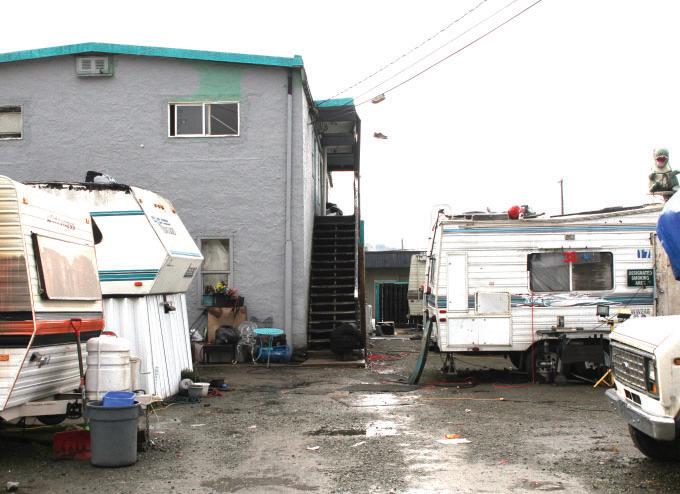
For years trailers sat next to the Wintergreen Apartments (pictured above and below) in Port Alberni on 4th Avenue, offering rental space for low rates. The City of Port Alberni identified the trailers as unsafe and illegal, and they were removed by November 2023.
lot that was cleared after a fire destroyed a low-rent apartment building in July 2013. Dozens of trailers were set up on the property, where the landlord reportedly charged $375-500 in monthly rent for those needing shelter.
Deemed unsafe and a violation of municipal bylaws, in November 2020 the city and fire department issued a remedial action requirement that the trailers be removed. But this didn’t happen until three years later, when tenants in the trailers had safe shelter available next door with the opening of the Wałyaqił Tiny Home Village, a fully staffed collection of small units for marginalized residents run by the Port Alberni Friendship Center.
A disproportionately high number of Port Alberni’s homeless continue to be Indigenous, according to a point-in-time count conducted on April 30 by the province and the BC Association of Aboriginal Friendship Centres. On that day 49 per cent of respondents identified as Indigenous, while just 15 per cent of Port Alberni’s population are classified as Aboriginal in the most recent census data. Of these Indigenous respondents, 82 per cent reported having lived in the community for more than a year, while 53 per cent had been in the foster care system during their youth.
Of all that were surveyed, the reasons for housing loss were varied. Thirty-two percent cited not enough income, 24 per cent attributed homelessness to substance use and 17 per cent said they had to leave their past housing because of unlivable conditions.
“An experience of homelessness is almost always the result of more than one event,” states the homeless count report. “Often, income challenges are pushed to a crisis by an event, such as a health challenge, relationship change, or eviction.”
Addictions and mental health
One day in the middle of December Joe Williams was confronted with the state of Port Alberni’s homelessness issue, when he saw a man sleeping on the ground by the former Zeller’s building in the uptown area.
“There’s four inches of snow on the ground, he’s laying there shivering,” says Joe. “I got out of my car, gave him my coat, came back down here and got a sleeping bag for him.”
He’s personally seen that the path to homelessness is complex.
“Before the drug epidemic with crack and meth and all this stuff, people always had a couch to go sleep on, people always had a home to go to,” he continues. “That’s gone now, they don’t have that anymore, because they’re sick. They’re sick with addictions or mental health.”
He admits to not responding well to rules or being told how to live, but hopes a solution can be found to his current dilemma.
“I want to make this my forever home,” says Joe. “You start to think differently about life when you’ve got more years behind you than you have ahead of you.
That’s where I’m at.”

lot in Port Alberni.

Elders support employment training through NETP
Job and career program now has a roster of elders ready to assist clients by ‘getting the generations connected’
By Eric Plummer Ha-Shilth-Sa Editor
Campbell River, BC - Elders are now playing a role in employment training programs being offered by the Nuu-chahnulth Tribal Council.
Senior members of each of the NTC’s 14 nations have now undergone workshops to prepare them to assist with essential skills training and certificate courses being offered by the Nuu-chahnulth Employment and Training Program.
This gives NETP a long roster of elders to draw from to support its employment training sessions – an involvement that brings additional income to senior Nuuchah-nulth-aht as well.
NETP Manager Melanie Cranmer says elders on their list are usually hired for a full or half day to provide cultural and spiritual support, including giving prayer, readings and songs to ensure the continuity of traditions.
“It’s about getting the generations
Phrase
connected, particularly connecting the elders with youth,” said Cranmer. “They will offer a prayer at the beginning of the workshop to start the groups off grounded and connected, or before the meal.”
Uchucklesaht member Gloria Rush has worked with NETP for the past three years offering elder support. She recalls a carpentry course she was supporting each week for a month that brought a challenging situation.
“There was a younger man in the carpentry course that was yelling at one of the other elders,” said Gloria, who worked to mitigate the tension by acknowledging those involved. “How can I support the guy that was yelling? How can I support the elder?”
“We know how to deal with those situations,” she added. “We may be silent, but I feel that our presence is really helpful.”
The elders also bring a wealth of experience to support those engaged in NETP’s training programs.
Gloria’s sister Marie Samuel has worked
with the Tsow-Tun Le Lum Society, culturally supporting those in addiction.
“I still go there, they call me as an elder to be there. I go there usually for the week to be with the clients,” said Marie. “I say, ‘My door is open.’ They might want to come and see me. It really works well.”
On Oct. 17 a large group of elders finished a three-day workshop in Campbell River to help prepare them to support NETP programs. This was the third such workshop given to elders, which emphasized the need for them to take care of themselves first so that they can better support others. Many of the participants came away with an enhanced awareness of their own childhood trauma – including from residential school. They also howled through a laughing yoga session led by Lisa Watts, and explored diabetes issues and good eating habits over the three days.
The prior two workshops offered training in computer use, including connect-
ing with clients through the Zoom and Microsoft Teams programs.
“It included how would they offer their cultural knowledge in a group setting and on an individual basis,” said Cranmer. In the past NETP’s central and northern regions struggled to get elders who were prepared and ready to support, but after this third workshop Cranmer came away with a long list of committed candidates.
“Now we have a sufficient list to choose from, and our elders are even being recruited as elder supports in other NTC departments and their own nations,” she said.
The Nuu-chah-nulth Employment and Training Program has offices in Port Alberni, Tofino, Ucluelet and Gold River. It helps First Nations people get ahead in their job or career by offering employment-related services and programs throughout Nuu-chah-nulth territory on western Vancouver Island. NETP’s main office can be contacted at 250-723-1331.
of the week: Mu>say%a+%iš %uu%its%i +upa>i +imsit
Pronounced ‘Malth sa alt ish oh it’s say alt ee clu palth ee tlim sit’, it means the cold season is here now, time to have some hot soup! Supplied by ciisma.

Eric Plummer photo
On Oct. 17 a large group of elders finished a three-day workshop in Campbell River to help prepare them to support NETP programs. This was the third such workshop given to elders, who now assist with job and career training offered by the Nuu-chah-nulth Tribal Council.


The National Aboriginal Veterans Monument, located in Ottawa’s Confederation Park, pays tribute to the many First Nations, Inuit and Métis men and women who served in Canada’s armed forces, during a time when Indigenous people were not given the same rights as other Canadians.
Indigenous Veterans Day recognized across Canada
By Holly Stocking Ha-Shilth-Sa Editorial Assistant
Saturday November 8th, 2025, marks the 32nd year of recognizing National Indigenous Veterans Day, after the now country-wide occasion began in Winnipeg.
On November 8, 1993 in Winnipeg, Manitoba, Mayor Susan A. Thompson signed an official proclamation declaring the day “Recognition and Remembrance Day for Aboriginal Veterans”. Initiated by the National Aboriginal Veterans Association, the signing coincided with the opening of an exhibition at the Manitoba Museum.
National Aboriginal Veterans Association first began to push for the proclamation because Indigenous veterans were not recognized in Remembrance Day activities. Over 12,000 Indigenous people are estimated to have participated in both world wars and the Korean War, including 7,000 First Nations members, and approximately 300 died during these conflicts.
After the wars, enlisted Indigenous people returned home to continued discrimination, including in some cases denial of benefits, loss of Indian status, and expropriation of their land by the government for non-Indigenous veterans.
In 1994, the province of Manitoba officially recognized November 8th as Aboriginal Veterans Day, and the rest of Canada followed shortly after.
It was only in 1995 that Indigenous
veterans were allowed to lay wreaths commemorating their fallen comrades at the National War Memorial in Ottawa.
While National Indigenous Veterans Day is now recognized and observed across the country, the federal government has not officially made it a country-wide statutory holiday.
The first monument commemorating the role of Indigenous people during these three wars was dedicated in 2001 in Ottawa. On June 21, 2001 a national monument to the Indigenous Veterans was unveiled in Confederation Park in Ottawa. The unveiling is the result of the hard work and perseverance of the National Aboriginal Veterans Association, the Congress of Aboriginal Peoples and Senator Nick Taylor.
The monument was created by Cree artist Lloyd Pinay, and symbolizes the stories of First Nations, Inuit, and Métis people who served in wars and peacekeeping operations from the First World War to the present day. The monument features an eagle, figures representing Indigenous men and women, and the wolf, the bear and the bison.
“These symbols represent the spiritual strength of Indigenous warriors,” states Veterans Affairs Canada.
It took until 2003 for the Government of Canada to provide veterans’ benefits to First Nations soldiers who had been denied them in the past, and until 2019 for Métis veterans.
Veterans Affairs Canada photo
President’s Message
Another month has passed quickly and we are into November. Again, I send out my deepest sympathies to all of you who have lost a loved one.
In the first week of November I attended the First Nations Leadership Gathering in Vancouver. It is a gathering of First Nations leaders meeting with the B.C. cabinet. There were over 1,400 delegates, and over two days leaders took part in 1,300 meetings with either the minister, deputy Minister or assistant deputy minister. Meetings are only 15 minutes in length, so you have to be clear and concise in stating what you want and give the minister time to respond. It is the 10th year of these meetings. While the oneon-one meetings are carried on, in the plenary room there are sessions of interest where you can participate in a panel, ask questions and learn about various initiatives. This year there were panels on a major projects update, an economic and fiscal update, an honoring ceremony, a B.C. First Nations-led IRS investigations update, the UNDRIP action plan, data governance review, the Heritage Conservation Act and racism. It is a good time to network and advocate with other First Nations, organizations and government representatives.
I also attended the 17th Annual Indigenous Business Awards Gala. I gave the opening comments for the board of the BC Achievement Foundation who do the awards. Around 630 people attended to see awardees being honoured and support Indigenous business. Again, another event to network and advocate.
I attended the Ahousaht housing complex opening, known as the Citaapi Mahtii Housing Society apartment building in Port Alberni. It is a beautiful building that will house many Ahousaht Families. What a great achievement for Ahousaht.
I also attended the Port Alberni Friendship Center’s 60th anniversary celebration. Quite a milestone, 60 years of serving First Nations people living away from home in Port Alberni. It was an awesome celebration.
The annual Disability Access Awareness fair was also on during October. I listened to a very important presentation on dealing with grief. So much grief around us all the time and knowing how to deal with it is important. There were many good workshops during the two-day event and I thank the board and organizers for putting this on. If you have never been to this event, plan on it for next year, it would be well worth your time.
I spoke at the Vancouver Island Economic Summit regarding keeping the human element in our business while using artificial intelligence. I spoke of our oral culture and teaching methods, that we cannot lose our ways of haahuupa. We can make good use of artificial intelligence but never let it take the place of in person meetings and gatherings. Especially around families, we need to keep our family ties strong. I also spoke of how so much of our history has been written by non Nuu-chah-nulth people and how we should not now have artificial intelligence write our history for us. There is a large debate going on in First Nations communities as to whether we should be using artificial intelligence for retaining and use of our language. Privacy and confidentiality are part of that, but again, can AI bring the emotion and feeling of our language into teaching materials?
Prior to the First Nations Leadership Gathering with the province, BC First

Nations met to prepare. One of the critical items we were asked to bring up is the amount of racism and hatred that is arising more frequently. Last month, I talked about this in relation to the Musqueam/ Cowichan case and the Heritage Conservation Act transformation process. The racist comments are still continuing as property owners in Richmond where the court found Aboriginal title are overreacting and hitting out on the court’s decision. The court did not take their property away from them and had said that B.C. needs to negotiate and settle the title. So many mistruths and information are out there and people are acting out emotionally instead of really finding out what needs to happen. Of course, this case is going to be appealed – the premier said that within a day or two of the ruling. Nothing will happen on this until after an appeal and decision is rendered. But people are still worried about their property and saying outrageous things about First Nations title. The BC Conservatives are also creating further fear by stating wrong facts. The bottom line is that First Nations people are being subjected to racist remarks in public, on social media and in publications. We are asking the B.C. government to be speaking against this racism and also provide clear facts for people to rely on. It is too bad when First Nations people start to get ahead and the non-First Nations population tries to hold us back.
Aboriginal title has been confirmed in many court cases like Delgaamukw and Tsilqot’in. The courts unfortunately have described Aboriginal title as a “burden” on Crown and private land, as opposed to underling title but still recognizing it. Tsilqot’in had five per cent of its territory acknowledge as Aboriginal title lands. The courts have been clear that fee simple land has not taken away Aboriginal title and it still exists. In the Hupacasath TFL deletion case, the court ruled that the fee simple lands held by now Mosaic required them to continue to consult with Hupacasath, and the Crown should have consulted with Hupacasath before deleting the TFL off their private lands. Cowichan was not going to evict off lands where the court found title, but was planning on negotiating with B.C. their compensation for alienation from Aboriginal title lands. B.C. knows all of this and people in B.C. should also be aware of this. It seems to me people should be upset with B.C. and Canada for not completing treaty or other agreements to do with the settling of Aboriginal title. Clearly Racism continues to be a problem we need to confront.
Cloy-e-iis, Judith Sayers

NCN Mental Health Counselling
Tuesdays and Thursdays 8:30am – 4:30pm
4841 Redford Street, Port Alberni
NCN Mental Health Services – DropIn Counselling with Margaret Bird, Registered Clinical Counsellor and Play Therapist. For on and off reserve members of all ages of the Nuu-chahnulth Tribal Council. Call (250) 724-3939 to book your appointment.
Making Connections Women’s Group
Tuesdays: November 4, 18, 25
ʔumʔiiqsu Centre, CFW Boardroom
ʔuʔaałuki quqʷaasʔi (Look after other people). Making Connections: A group for Nuu-chah-nulth women to

&Community Beyond



come together and grow. Through the creativity of vision board making, we’ll explore healthy relationships, stress management, effective communication, setting boundaries, and defining what success means to each of us. Together, we’ll reflect on our past, embrace our present, and shape our future in a safe and supportive space. Light snacks and refreshments will be offered. Open to all Nuu-chah-nulth women ages 18+. To ask questions please contact: Celine Sauve: celine.s@huuayaht.org or call or text 250-731-5676
Healthy Babies
Mondays: 10am – 12:00pm
4841 Redford Street
NTC Child and Youth Services presents Mondays Healthy Babies Group. 10am12pm. Please enter the building through the 4th avenue side of the orange stripe building. Ring the doorbell to be let in.

25
Years Ago in
Ha-Shilth-Sa
Vol.
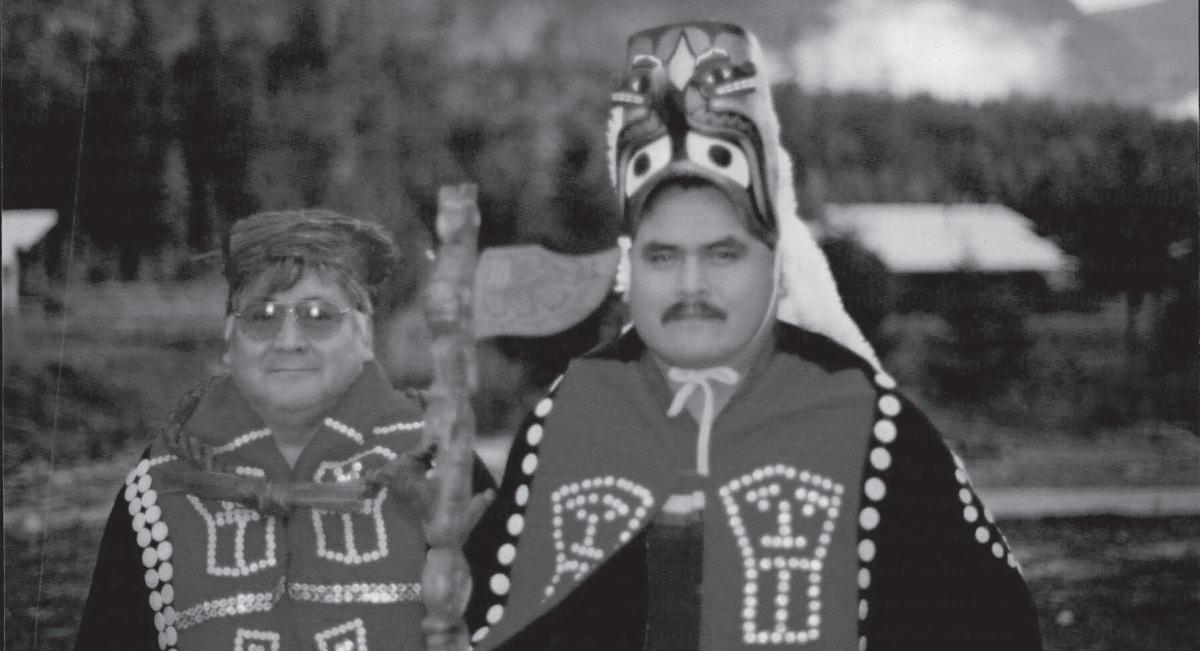
Jerry Jack Sr. hands down Chieftainship
More than 150 people came to Tsaxana for the weekend of November 10th and 11th, 2000, to honour the popular Chief, and witness the Tik’pitub to his son, then 38-year-old Jerry Jack Jr. The doors were locked, and lights turned off in the Wahmeesh Centre as the wolves came out to protect the Chiefly procession, owners of Mowachaht’s second house. The evening was filled with songs and dances belonging to the Jack family, before opening the floor to other Nations. A large delegation from the Makah Nation distributed gifts from relatives at Neah Bay. The weekend continued with song and dance by the
Hamatsa dancers, from the Namgis Nation, where the Jack family held the Glakways, or Potlatch Seat as part of a dowry from a wedding that happened many generations previously between the Jack and Alfred families. The dancers performed the fire dance, princess dance, peace dance and many more that all came from Jerry’s Namgis side. Throughout the weekend many speakers focused on inter-relations, and the powerful family backgrounds of Chief Jerry Jack Jr. from the west and east sides of Vancouver Island.
Employment and Training Opportunities



Port Alberni Friendship Centre Volunteers Needed
Need work experience? The Port Alberni Friendship Centre is looking for interested applicants for various positions. Call 250-723-8281


Red Collar Day seeks ways to find an end to dog culls
Every fall, dog shootings occur in rural and remote Indigenous communities to protect children and the elderly
By Nora O’Malley Local Journalism Initiative Reporter
Increased ACCESS, an Indigenous-led nonprofit that helps with animal management solutions, has created a new day to raise awareness about public health and safety inequities in Indigenous communities across Canada.
Nov. 1, 2025, marks the first Red Collar Day, a national day for truth, healing and shared responsibility — to ensure every community has the care, infrastructure, and respect needed to make dog culls, and the grief they cause, a thing of the past, says Increased ACCESS.
“It feels like an elephant in the room so often. I think it’s high time to start addressing the issue. If we don’t talk about it, we can’t deal with it,” said James Rodgers, executive director for Increased ACCESS.
“One of the challenges we have is it’s often framed as a very simple solution: ‘Hey, just come in and take the dogs or shoot the dogs’. But it’s much more complex than that. If we don’t honour the complexity of the challenge, it will just be an ongoing cycle,” he said.
Increased ACCESS says the lack of community animal management in rural and remote Indigenous communities is a public health failure and a breach of Canada’s fiduciary duty of care toward First Nations. The non-profit is calling for equal access and sustainable funding to services people in urban centres often take for granted, like veterinarians, kennels or animal-control services.
“The removal of dogs is probably the fastest solution, but the challenge is what do we do with the dog? It’s not a slam dunk to come in and take away bity dogs,” said Rodgers.
At the beginning of October, a First Nations community on the west coast of Vancouver Island rounded up all “dogs that pose a threat” and put them down to protect their community members, especially children and elders, from dog biting.
“There is so much judgement towards communities that have to face this reality. I don’t want to name any communities out of respect for fear they will be marginalized and judged,” said Rodgers, noting that this is an issue rural communities across Canada deal with.
“Without any other resources they are left looking at the option of shooting dogs. In some cases they tell their citizens to put brightly coloured collars on the dogs that have homes and families so that they don’t get shot. That’s how we came up with Red Collar Day,” he continued.
Tla-o-qui-aht First Nation member Shawn Quick is on the board of directors for Increased ACCESS. He said Tla-o-

qui-aht is proud to participate in Red Collar Day.
“Our remote communities haven’t had the same resources to manage abandoned or roaming animals, and that has been traumatic for those of us who’ve been left to deal with it. I know first-hand how tragic these ‘dog shoots’ can be – I used to be the person my community called in those situations,” Quick shared in an email.
“It’s wrong that so many rural and remote communities remain chronically under-resourced and have to rely on the only means available to keep people safe. This is a policy problem that governments can fix – and have a fiduciary duty to fix. Red Collar Day is a call to action for everyone,” said Quick.
‘We just need to do better’
Increased ACCESS says creating community-led animal management plans is the most preventable step towards closing the gap between animal and human health in remote Indigenous communities.
They say investments in infrastructure like kennels, mobile vet care and leveraging things like disconnecting Internet service to individuals not complying with community bylaws could also help.
“There is a very clear path from around the 1876 mark forward to why this is still an issue today. We just need to do better,” said Rodgers. “This isn’t about an animal welfare idea or challenge. This is about public health.”
In the late 1800s, Canadian towns and cities used local tax bases to evolve municipal pound and animal-control services, according to Increased ACCESS. At the same time, SPCAs were being


established to promote humane treatment of animals and, in some cities, to provide sheltering services, says the nonprofit. They say Indigenous communities were prevented from building comparable systems. Under the Indian Act, communities were denied the ability to create local tax bases and to direct their own funds; finances were kept deliberately limited and controlled by Indian Agents. Although the 1876 Indian Act mentioned a “pound-keeper” role, it provided no funding or infrastructure to make that job viable, said Increased ACCESS.
Canadian statistics related to dog bites are unreliable and dated as “most dog bites go unreported”, says Rodgers. A summary of data from 1996 shows that five- to nine-year-olds most frequently sustained dog bites, and the body part
most often affected was the face.
According to Vancouver Island Health Authority (VIHA), there were 2,000 bites recorded between Jan. 1 and Oct. 30, 2025, at the eight major hospitals on the Island (Campbell River, Comox, Nanaimo, Duncan, Port Alberni and three on the South Island). Of those 2,000 bites, 157 were recorded at the West Coast General Hospital in Port Alberni.
“That does not mean those are all dog bites. It could be a spider, could be a bat, could be a snake,” said VIHA media representative Dominic Abassi.
To participate in Red Collar Day, Increased ACCESS encourages people to raise awareness by sharing posts and images using the hashtags #RedCollarDay and #EqualCareEqualCommunity.
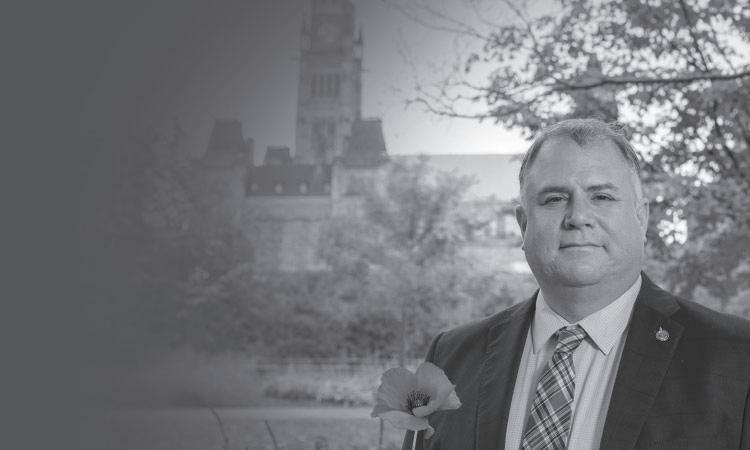
Increased ACCESS photos
Red Collar Day is about equal dog care for every community across Canada, particularly in remote First Nations villages.
Mobile vet clinics like Mission Pawsible in B.C. is one solution to bridge the gap between animal and human health in remote Indigenous communities.
